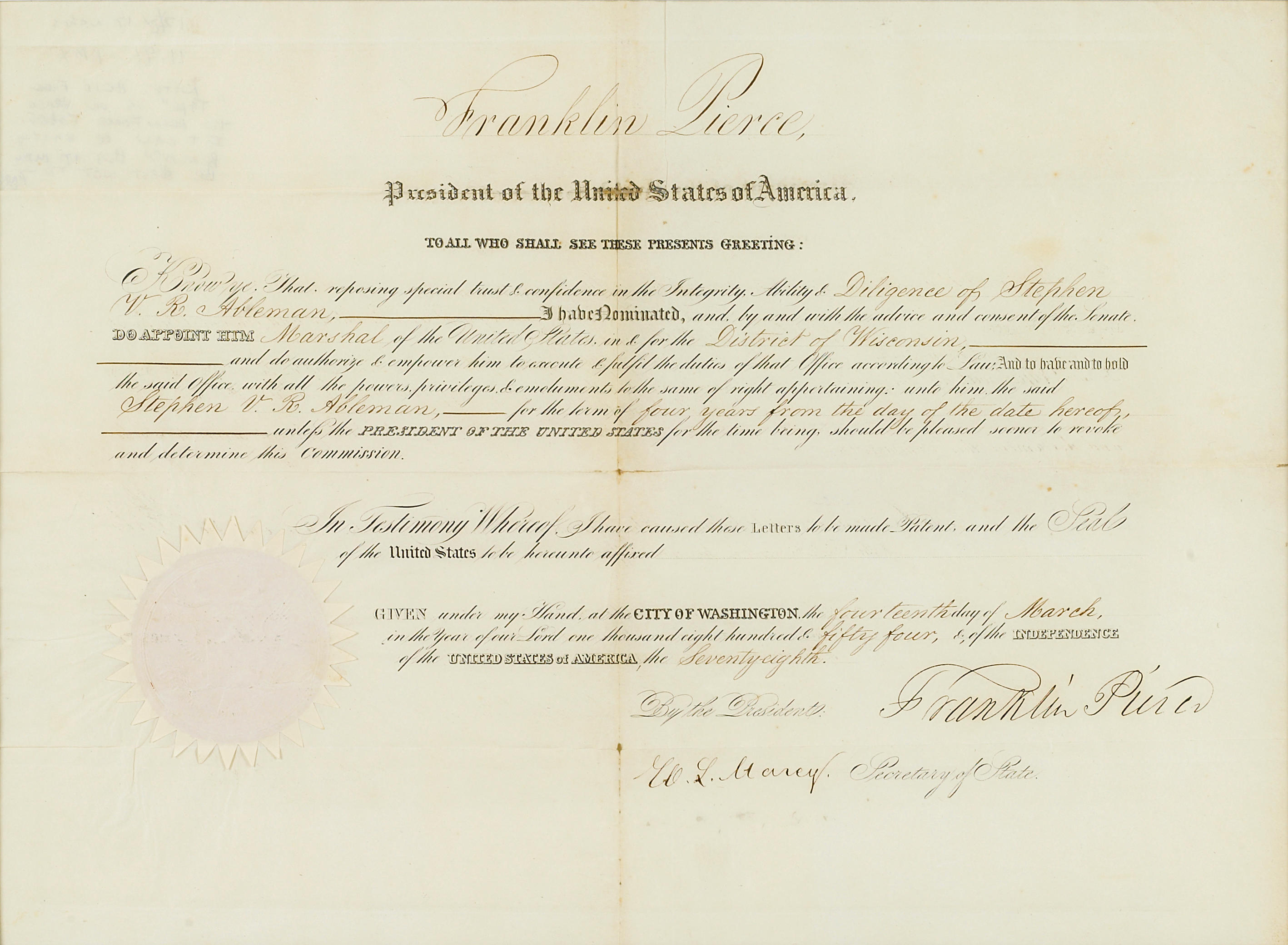appointment of William Johnston to Office of Commissioner for Mahoning County, OH, 25 Oct. 1871. 14 x 16.5". Hayes served as Governor of Ohio from 1868-1872 and 1876-1877, when he assumed the presidency of the United States (1877-1881). At the outbreak of the war, the membership of the Cincinnati Literary Club, of which Hayes was a member, made up a military company. Hayes received commission after commission, being promoted to colonel in 1862. He was wounded at the Battle of South Mountain (MD) in Sept., being the only President who served in the Civil War to be wounded in that conflict. When he returned in December, he was brevetted Brig. Gen., and promoted to Brig. Gen. and brevetted Maj. Gen. after the Shenandoah campaign. Hayes was wounded four more times and had four horses shot from under him. When nominated to run for Congress as a Republican in 1864, Hayes refused to campaign, since he had what he considered more important things to do. Apparently, the voters of Ohio agreed, because they elected him to the 39th Congress. After the war, he remained in politics, becoming the "dark-horse" candidate for the Republican party in 1876. After the scandal-ridden Grant administration, Hayes was notable for his honesty and diplomacy. One journalist at the time, Henry C. Adams described him as a "third rate nonentity" - just the way Hayes wanted it. Hayes quietly changed several aspects of American society, although he is something of an "invisible" president. He ended Reconstruction, allowed female attorneys to argue cases before the US Supreme Court, and attempted to reform civil service. The greatest controversy in Hayes' administration was the use of Federal troops to end labor riots. He also made the first attempt to build a canal through the isthmus of Panama, although it would not be until Roosevelt that this feat would be accomplished. Hayes did not run for re-election, keeping a pledge made in his inaugural address. He proposed limiting the president to one term, but expanding that term to 6 years. Hayes returned to Ohio, and served on the board of OSU, a school he helped to found during his term as governor. He died of a heart attack in 1893. Condition: Toning, minor chips along right edge with some paper loss. Water stain at top and "ghost" of top print on bottom where document was folded.
appointment of William Johnston to Office of Commissioner for Mahoning County, OH, 25 Oct. 1871. 14 x 16.5". Hayes served as Governor of Ohio from 1868-1872 and 1876-1877, when he assumed the presidency of the United States (1877-1881). At the outbreak of the war, the membership of the Cincinnati Literary Club, of which Hayes was a member, made up a military company. Hayes received commission after commission, being promoted to colonel in 1862. He was wounded at the Battle of South Mountain (MD) in Sept., being the only President who served in the Civil War to be wounded in that conflict. When he returned in December, he was brevetted Brig. Gen., and promoted to Brig. Gen. and brevetted Maj. Gen. after the Shenandoah campaign. Hayes was wounded four more times and had four horses shot from under him. When nominated to run for Congress as a Republican in 1864, Hayes refused to campaign, since he had what he considered more important things to do. Apparently, the voters of Ohio agreed, because they elected him to the 39th Congress. After the war, he remained in politics, becoming the "dark-horse" candidate for the Republican party in 1876. After the scandal-ridden Grant administration, Hayes was notable for his honesty and diplomacy. One journalist at the time, Henry C. Adams described him as a "third rate nonentity" - just the way Hayes wanted it. Hayes quietly changed several aspects of American society, although he is something of an "invisible" president. He ended Reconstruction, allowed female attorneys to argue cases before the US Supreme Court, and attempted to reform civil service. The greatest controversy in Hayes' administration was the use of Federal troops to end labor riots. He also made the first attempt to build a canal through the isthmus of Panama, although it would not be until Roosevelt that this feat would be accomplished. Hayes did not run for re-election, keeping a pledge made in his inaugural address. He proposed limiting the president to one term, but expanding that term to 6 years. Hayes returned to Ohio, and served on the board of OSU, a school he helped to found during his term as governor. He died of a heart attack in 1893. Condition: Toning, minor chips along right edge with some paper loss. Water stain at top and "ghost" of top print on bottom where document was folded.









.jpg)


.jpg)
.jpg)
.jpg)
Testen Sie LotSearch und seine Premium-Features 7 Tage - ohne Kosten!
Lassen Sie sich automatisch über neue Objekte in kommenden Auktionen benachrichtigen.
Suchauftrag anlegen